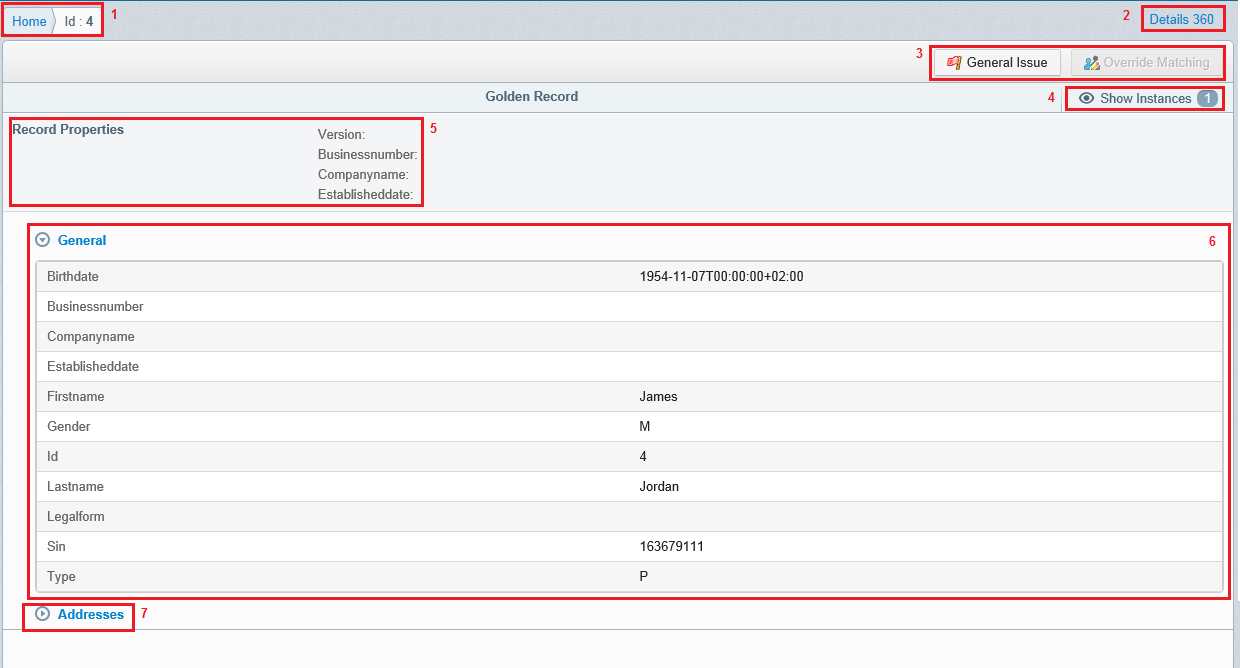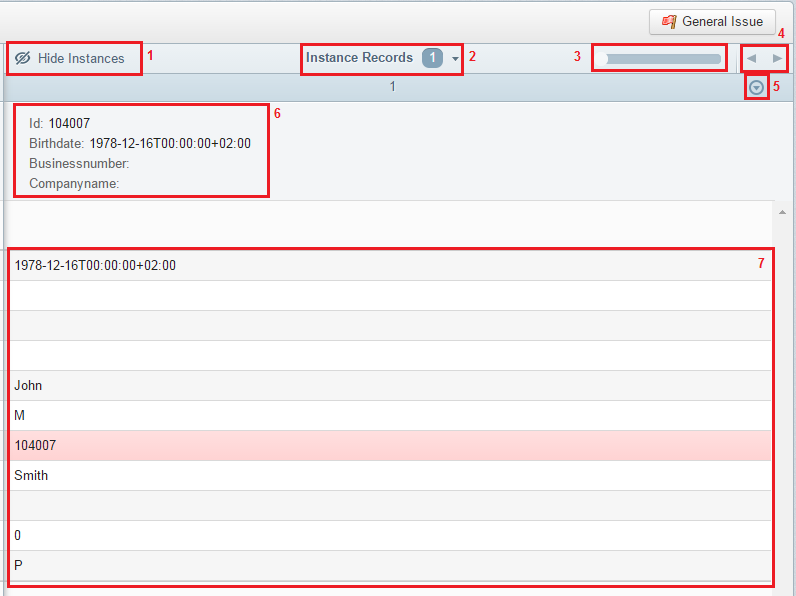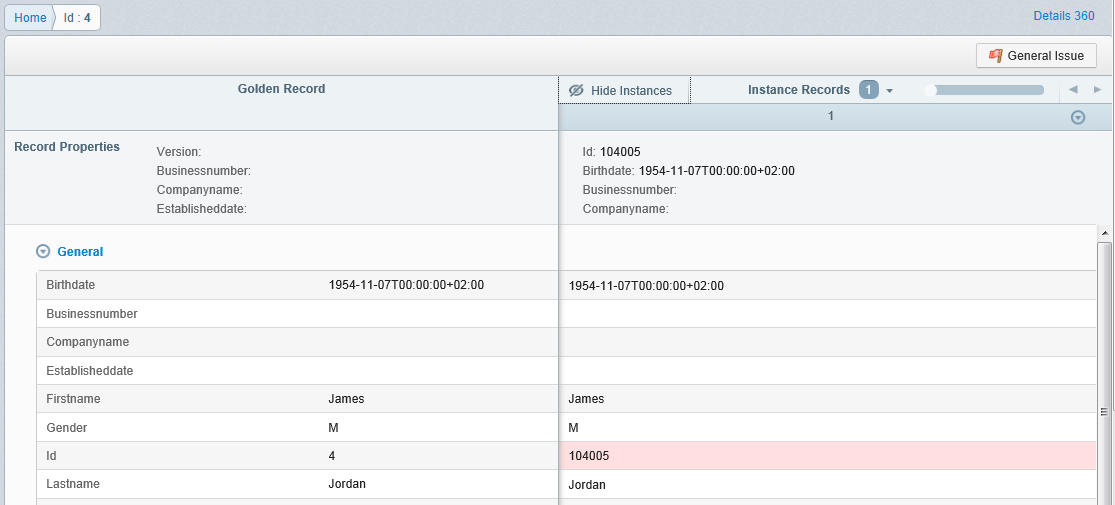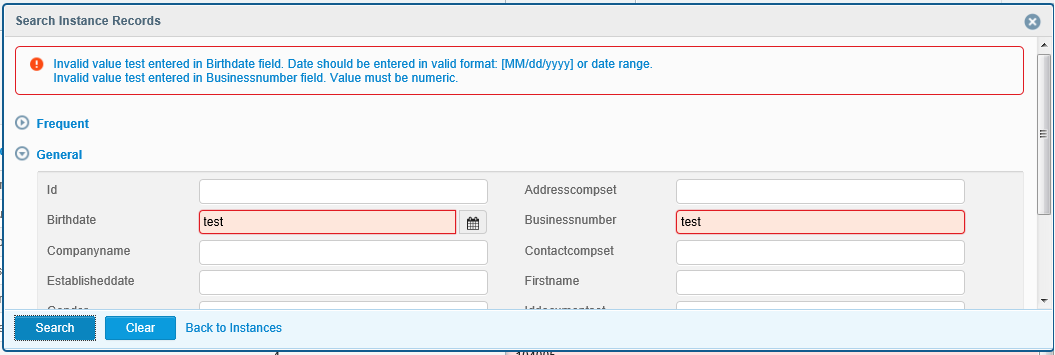Master Comparison Page
|
Topics: |
You can compare Instance records with other Instance records and Golden records.
To view the Master Comparison page of the Golden record, click the Master Comparison link of the specific record on the Home page or Search Results page.
The following list shows the sections of a Master Comparison page corresponding to the image below.
- Breadcrumbs trail for navigating to previously visited pages.
- Details 360 link for navigating to the Details 360 page of the record.
- General Issue and Override matching buttons for creating general issues or overriding matching cases (if the Remediation functionality is enabled).
- Show Instances link for expanding the Instance records section.
- Record Properties section which displays general information about the record.
- Grouped attribute section(s).
- Sub-domain(s) section(s).

The Record Properties are displayed on the top of the page and can be configured using the Administration Console. For more information, see Using the Administration Console.
By default only data from Golden records are displayed on the Master Comparison page.
The data is organized into sections that can be configured using the Administration Console. For more information, see Using the Administration Console.
The items of collections which represent sub-domain data are displayed hierarchically in expandable sections (collapsed by default) and can also be configured using the Administration Console. For more information, see Using the Administration Console.
Click the Show Instances link to view all Instance records corresponding to the current Golden record. This link displays the number of Instance records for the Golden record. The candidate section is expanded to the right of the Golden record.

The following list describes the structure of Instance records, corresponding to the image above:
- Hide Instances link, used for collapsing the whole section.
- Instance records label, used for opening the list of Instance records.
- Slider, used for changing the number of Instance records displayed on the page at once (it is disabled when there is only one Instance record).
- Navigation arrows, used for navigating between Instance records that are not displayed on the page (they are disabled when there is only one Instance record)
- Drop down menu for each Instance record
The Record properties section displays general information about each Instance record. Viewing this section can be configured using the Administration Console. For more information, see Using the Administration Console.
- Grid with values of each Instance record.
The Instance record's information is displayed next to the Golden record so that it may be compared easily. Values of attributes in each Instance record that are different from the attribute value in the Golden record itself are highlighted with a pink color. The values that were standardized are highlighted with a yellow color.

Note: The size of the Golden record and Instance record sections can be changed by moving the divider between those sections.
Subdomains are essential attributes of the Golden record that are not uniquely identified in the record. Subdomains are almost always a many-to-one relationship with the base record. These subdomains can be names, addresses, and contact information (for example, emails and phone numbers). However, one Instance record can have two names in a collection, and another Instance may have three. The resulting Golden record may be a UNION of values across Instances.
Instance records can have a different number of items in the collections and not all items are used to compose the Golden record. The items that are used in Golden records are highlighted in green borders. Values of attributes in each Instance record, that are different from the attribute value in the Golden record itself, are highlighted in pink. The values that were standardized are highlighted in yellow. Sub-domains that fully coincide with appropriate Instance records have green borders.
Instance Records Overlay Window
If you wish to see the list of all Instance records that correspond to the selected Golden record, you can open the Instance records overlay window by clicking the Instance records label.

The Instance records overlay window consist of:
- The Advanced Search link that opens the Advanced search panel.
- The list of Instance records showing all Instances or Search results.
- The Done button that closes the dialog and displays the selected Instance records on the Master Comparison page.
If there are many Instance records corresponding to the current Golden record, you can open a full list of Instance records and select some records to be displayed in Comparison mode. You can also search for a desired Instance record by using the Advanced Search by any attributes available.
Clicking on the title of the Instance records section, provides a list of all Instance records corresponding to the current Golden record. All the records in the list are selected by default. If the list is long, the scrollbar inside the overlay window is displayed. For each Instance record, fields can be configured using the Administration Console. For more information, see Using the Administration Console.
Currently displayed records are selected and highlighted. To select or deselect records, select or clear the appropriate check boxes. When you are finished with your selection(s), click Done to close the overlay and refresh the Comparison view to show selected Instance records.
At least one record must be selected before clicking Done. If no records are selected, a validation message appears, as shown in the following image.

Advanced Search (for Instance Records)
To search by different parameters (for example, find all Instance records that have a particular Date Of Birth, the same as in a Golden record), you can use the Advanced Search link. When you click Advanced Search, the overlay window is enlarged. You can then enter any number of criteria and click the Search button.
Note: Only strict searches are supported. Wildcard searches and searches using the OR operator (or comma) are not supported.
The Advanced Search dialog consists of the following sections, corresponding to the image below.
- Grouped attribute sections for setting search parameters.
- Search and Clear buttons.
- Back to Instances link.

Note: For now, searching by sub-domain attributes is not supported.
The attributes in the Advanced Search dialog are grouped into sections to make it easier for you to find the required attribute. This can be configured using the Administration Console. For more information, see Using the Administration Console. Only one section can be expanded at a time. For example, when another section header is clicked, the new section is opened and the previously opened one is closed.
Clicking the Search button allows you to see a list of search results which consists of matching Instance records corresponding to the current Golden record.
The Clear button deletes all entered criteria.
Clicking Back to Instances closes the Advanced Search dialog, and causes the Instance records overlay to appear.
If you already have Advanced Search results and you return to the search overlay to edit search criteria, the previous values you entered in the query are preserved.
There is also a validation mechanism for numeric fields and fields with a date format. After invalid data is entered and you click Search, the appropriate validation message appears and the corresponding field is highlighted in red, as shown in the following image.

Search Results Page (for Instance records)
After Search is performed by existing criteria, the resulting number of rows is displayed. All records are selected by default. The search query parameters are summarized above the search results, and the Discard Search link appears for discarding search and displaying the list of Instance records.

When you perform a search by non-existing criteria, the appropriate message is displayed on the Search results page and the Done button is disabled, as shown in the following image.

You can navigate to the Advanced Search dialog by clicking the Advanced Search link or return to the full list of Instances if you click the Discard Search link.